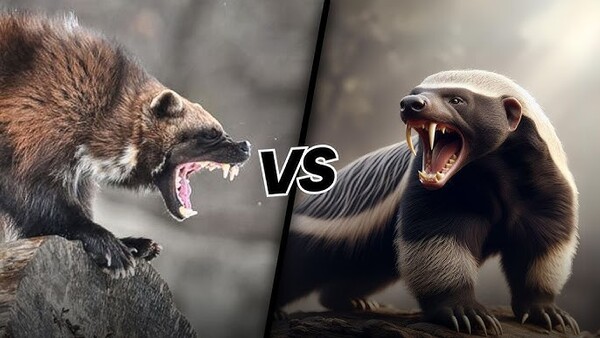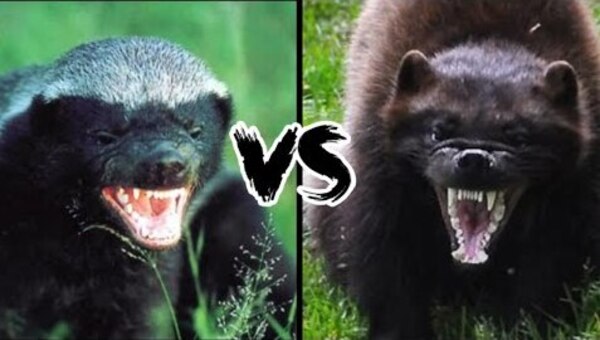When it comes to raw tenacity and ferocity in the animal kingdom, two creatures stand out: the wolverine and the honey badger. Despite their vastly different habitats and lifestyles, these animals are often compared for their reputation as fearless, almost indestructible predators. Let’s dive into a comprehensive exploration of these two legends and settle the debate: who’s the ultimate survivor?

Introduction: The Legends of the Wild
Wolverine: The Ghost of the North
Habitat and Distribution
Physical Characteristics
Diet and Hunting Behavior
Key Survival Traits
Honey Badger: The Fearless Fighter
Habitat and Distribution
Physical Characteristics
Diet and Hunting Behavior
Key Survival Traits
Head-to-Head: Wolverine vs. Honey Badger
Size and Strength
Defense Mechanisms
Fighting Tactics
Intelligence and Adaptability
The Verdict: Who Would Win in a Fight?
Ecological Significance: Guardians of the Wild
Fun Facts and Cultural Legacy
Conclusion
The wolverine (Gulo gulo) and honey badger (Mellivora capensis) are both iconic for their unmatched courage and survival skills. While one roams the icy tundras of the North, the other prowls the scorching savannas of Africa. These animals have little in common biologically but share a reputation for taking on challenges that far exceed their size.

Wolverines are found in the boreal forests, alpine tundras, and Arctic regions of North America, Europe, and Asia. They thrive in cold, remote environments, using their thick fur and incredible stamina to navigate snowy landscapes.
Size: Wolverines can weigh up to 55 pounds (25 kg) and grow to about 3 feet (1 meter) in length.
Appearance: Stocky and muscular, with short legs and sharp claws designed for digging and climbing.
Fur: Dense and frost-resistant, perfect for subzero temperatures.
Wolverines are opportunistic feeders. They scavenge carcasses, hunt small mammals, and even take down prey larger than themselves, such as deer. Their powerful jaws can crush bones, allowing them to extract every last nutrient.
Endurance: Known for traveling vast distances daily in search of food.
Aggression: Wolverines are highly territorial and will confront much larger predators, like bears or wolves, to protect their kills.
Adaptability: Their ability to climb trees and swim makes them versatile hunters.
The honey badger is native to Africa, the Middle East, and parts of India. They inhabit a range of environments, from dry deserts to lush forests, showcasing their incredible adaptability.
Size: Smaller than wolverines, weighing up to 35 pounds (16 kg) and measuring about 2.5 feet (0.8 meters).
Appearance: Sleek but tough, with loose, thick skin and a distinctive black-and-white color pattern.
Skin: Their loose skin allows them to twist and fight back even when grabbed.
Honey badgers have a varied diet, ranging from insects and snakes to birds and small mammals. Their name comes from their love of raiding beehives, enduring painful stings to get to the honey.
Venom Resistance: Honey badgers can withstand bites from venomous snakes like cobras and continue fighting.
Ferocity: Known for attacking animals much larger than themselves, including lions.
Problem-Solving Skills: Highly intelligent, honey badgers can use tools and escape enclosures.
Wolverine: Larger and more muscular, with a stronger bite capable of crushing bones.
Honey Badger: Smaller but incredibly resilient, with loose skin and sharp claws.
Wolverines are larger and bulkier, with more muscle mass. Honey badgers are smaller but have a compact, resilient build.
| Attribute | Wolverine | Honey Badger |
|---|---|---|
| Weight | Up to 55 pounds | Up to 35 pounds |
| Bite Force | Strong, bone-crushing | Moderate |
| Skin Toughness | Normal | Thick, loose, tough |
Wolverine: Relies on brute force and intimidation, often scaring off competitors.
Honey Badger: Combines thick skin, venom resistance, and relentless aggression to outlast opponents.
Wolverine: Prefers direct confrontations, using its size and strength to overpower.
Honey Badger: A master of counterattacks, often targeting vulnerable areas like the face or throat.
Both animals are highly intelligent, but honey badgers are known for their cunning problem-solving abilities, like using tools to break into enclosures or outwit predators.
While the wolverine’s size and power give it an edge, the honey badger’s agility, venom resistance, and relentless attitude make it a formidable opponent. In a neutral setting, the fight could go either way, depending on who tires out first or lands a decisive blow.
Wolverines: Scavengers that help clean up ecosystems, they also control prey populations like rodents and hares.
Honey Badgers: Natural pest controllers, they play a role in keeping insect and small mammal populations in check. Their habit of raiding beehives can even encourage plant pollination.
The wolverine is a symbol of strength and resilience, inspiring the Marvel superhero. Native folklore often depicts them as cunning tricksters.
Known as the "world's most fearless animal," honey badgers have become internet sensations thanks to videos showcasing their daring battles against lions, snakes, and other predators.
Though these two animals live in vastly different environments, fans of wildlife often imagine hypothetical encounters between them, adding to their legendary status.
Both the wolverine and the honey badger are remarkable examples of nature’s ingenuity and toughness. Each dominates its respective habitat, showcasing unique traits that make them survivors. Whether you’re rooting for the wolverine’s brute strength or the honey badger’s indomitable spirit, one thing is certain: these animals embody the wild’s most incredible qualities.
In the end, it’s not about who would win—it’s about celebrating their incredible ability to thrive against all odds. Which team are you on: Team Wolverine or Team Honey Badger?
animal tags: wolverine-vs-honey-badger
We created this article in conjunction with AI technology, then made sure it was fact-checked and edited by a Animals Top editor.